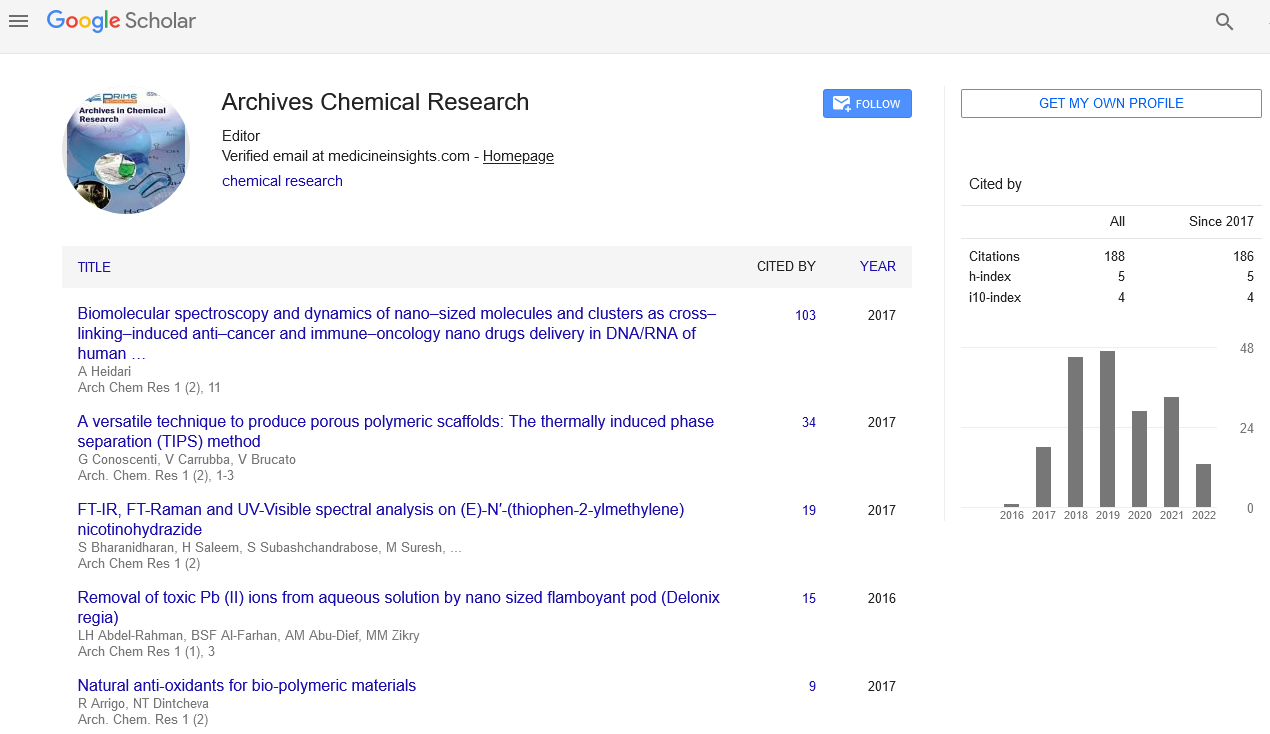Banglin Deng*
Department of Mechatronics and Control
Engineering, Shenzhen University,
Shenzhen 518060, China
- *Corresponding Author:
- Banglin Deng
Department of Mechatronics and Control
Engineering, Shenzhen University, Shenzhen
518060, China
E-mail: dengbanglin123@126.com
Received Date: October 07, 2021; Accepted Date: October 14, 2021; Published Date:October 21, 2021
Citation: Deng B (2021) Preparation of
Hybrid Nano Fibers using Energy Saving
Process. Arch Chem Res. Vol.4 No.4:20
Perspective
Electro spinning, an abbreviation of electrostatic spinning, belongs to an electro hydrodynamic atomization (EHDA) method. Based on the strong, intensive and fast interactions between the electrostatic energy and the electrospinnable polymeric fluid, solid Nano fibers can be generated within the time scale of several milliseconds. This kind of “top‐down” Nano fabrication method has its unique advantages, such as a single‐step and straightforward preparation process, convenient for functionalization, after treatment, and further conversion. Thus, it is no strange that it has rapidly penetrated into almost all the applied scientific fields with the surge of Nano science and technology during the past three decades. Presently, more and more attention has been paid to the creation of Nano fibers on a large scale and their potential commercial products. Under this situation, energy saving for reducing the cost should be a very important issue, particularly; electro spinning treats and converts materials by direct application of the high‐voltage electrostatic energy.
A novel sort of hybrid Nano fibers were generated for simultaneously controlling the drug release location and the drug release rate. Due to the wide application of aspirin in the treatment of COVID‐19 patients, as well as the fact that the side effects of aspirin came from two aspects(strong stimulation to the stomach and toxic side effects caused by excessive dose), it was chosen as the model drug here. Moreover, Eudragit S100, an enteric soluble polymer, was selected as the filament‐forming polymeric matrix proposed to prevent the release of aspirin in the stomach.
The homemade electro spinning system was composed of four parts. A high‐voltage (60 kV/2 mA) power supply (ZGF2000, Shanghai Sute Corp., Shanghai, China) and a syringe pump (KDS100, Cole‐Parmer, IL, and USA) were used. The spinneret was homemade. A piece of aluminum foil was wrapped up on a cardboard used as the fiber collector. Preparation of spinnable solution: the concentrations of aspirin, lecithin and Eudragit® S100 dissolved in the mixed solvent were 3.0, 3.0 and 12.0 g/ mL, respectively. Based on the pre‐experiments, the processing parameters of electro spinning were fixed as follows: the applied voltage was set at 14 kV; the flow rate was adjusted at 1.0 mL/h; and the distance between the spinneret and the collector was fixed at 20 cm.
In vitro dissolution tests measuring drug‐controlled release profiles from the hybrid Nano fibers were carried out by paddle method according to Method II, as described in Chinese Pharmacopoeia. The fiber samples were weighed for 0.2 g and firstly placed in an HCl solution (pH=2, simulated artificial gastric fluid without enzyme) for 2 h, then transferred into the phosphate buffer saline (PBS, pH=7.2, 0.1 mol/L, enzyme‐free artificial intestinal fluid). The temperature of the in vitro dissolution apparatus (ZRS‐8G, Radio Factory of Tianjin University) was set at (37.0±0.5) °C and the paddle rotation speed was maintained at (50±2) r/min. At the pre‐ determined time point, 5.0 mL of samples were withdrawn and the same‐volume PBS medium was replenished. The samples were filtered through a 0.22 μm cellulose membrane (Millipore, USA). After direct and appropriate dilution to the filtrate, samples were analyzed at λ max=278 nm using an UV‐Vis spectrophotometer. The drug concentration and cumulative release percentage were calculated according to a calibration curve. All experiments were repeated 6 times.
In an electro spinning system or a set of electro spinning equipment, the spinneret is the most important component. The other three devices, the high voltage power supply, the syringe pump and the collector, respectively, operate for providing high‐voltage electrostatic energy, measuring and pushing the working fluid accurately, and receiving the prepared Nano fibers. The structure of the spinneret determines the distinction and classification of the electro spinning process, for example, the spinneret with a core‐sheath structure refers to coaxial electro spinning, the spinneret with a Janus structure refers to side‐byside electro spinning, the spinneret with a complicated multi-compartment structure refers to multi‐fluid electro spinning, and the “free surface” of the fluid refers to needle‐less electro spinning.
In this study, a new type of electro spinning technology was developed, which integrated the advantages of needle electro spinning, free surface electro spinning and coaxial electro spinning. The technology was characterized by a new type of coaxial spinneret with a solid core. Through the application of this spinneret, a new type of multi‐component hybrid Nano fibers was prepared, which was composed of drug aspirin, fiber forming polymer substrate Eudragit, and lecithin. SEM and TEM results showed that the Nano fibers had good linear morphology, and there were many tiny islands due to solid phase separation. XRD results showed that the drug existed in an amorphous state in the fiber. FTIR results showed that the components had good compatibility. In vitro dissolution results verified that the drug‐loaded Nano fibers had dual functional effects of sustained release and colon‐ targeted release. The prepared aspirin loaded fibers could be further converted into solid oral dosage form in the future, providing an alternative for various patients, including patients with COVID‐19 infections.

